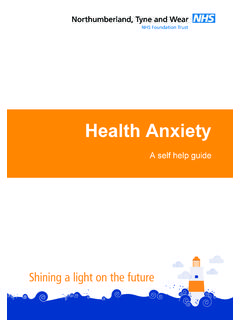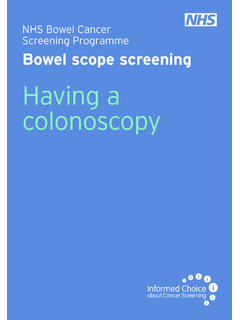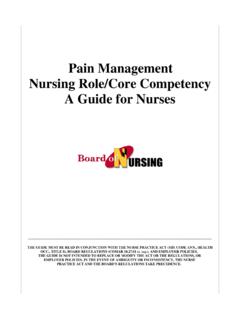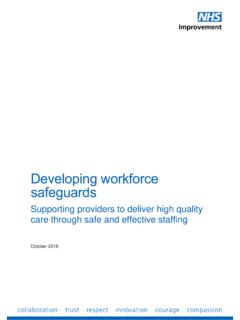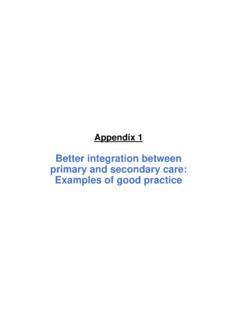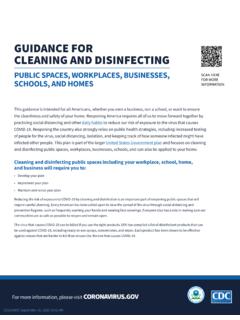Transcription of Quick Guide: Discharge to Assess - NHS
1 Quick guide : Discharge TO ASSESSTRANSFORMING URGENT AND EMERGENCY CARE SERVICES IN ENGLANDThis is one of a series of Quick , online guides providing practical tips and case studies to support health and care Imagine leaving your home abruptly and never returning to it again. Imagine being told that you are moving house tomorrow and you have no control over where you are moving to and how much it will is what happens to people every day because we Assess people in a place that is not their normal environment. This Quick guide aims to support local health and social care systems to reduce the time people spend in hospital, at the point that they no longer need acute care. It provides practical tips and advice to commissioners and providers on Discharge to Assess (D2A) models, including best practice from across the country and should be read alongside the 2015 NICE guideline, Transition between inpatient hospital settings and community or care home settings for adults with social care needs.
2 Unnecessary delay in discharging older patients from hospital is a systemic problem with a rising trend - the National Audit Office reported that between 2013 and 2015 recorded delayed transfers of care rose 31 per cent and in 2015 accounted for million bed days. For older people in particular, we know that longer stays in hospital can lead to worse health outcomes and can increase their long-term care possible, people should be supported to return to their home for assessment. Implementing a Discharge to Assess model where going home is the default pathway, with alternative pathways for people who cannot go straight home, is more than good practice, it is the right thing to first two scenarios require commissioners and providers within health and care systems to challenge current practice and change mind-sets.
3 Collaboration between health and care locally is vital to ensure sufficient quality of service, demonstrable change and agreement on how best to allocate resources and Clinically optimised is described as the point at which care and assessment can safely be continued in a non-acute setting. This is also known as medically fit for Discharge medically optimised. NHS England (2015). Monthly Delayed Transfer of Care Situation Reports Definitions and Guidance London OF Discharge TO Assess Where people who are clinically optimised 1 and do not require an acute hospital bed, but may still require care services are provided with short term, funded support to be discharged to their own home (where appropriate) or another community setting.
4 Assessment for longer-term care and support needs is then undertaken in the most appropriate setting and at the right time for the person. Commonly used terms for this are: Discharge to Assess , home first , safely home , step down .This does not detract in any way from the need for agreed multi professional assessment or from the requirement to ensure safe Discharge and it may work alongside time for recuperation and recovery, on-going rehabilitation or reablement. MYTH BUSTINGIt is the responsibility of all local stakeholders to make sure patients, carers and their representatives understand that this is NOT about: Discharging people from hospital before they are clinically ready. Discharging people without assessment for services required for their safety at home or another community setting.
5 Moving people home from hospital without the right support and without their consent or a best interests decision. Creating an additional transfer in a person s care pathway in order to free up a hospital bed, without adding value to their experience of care or meeting good outcomes for the person. Moving people without clear pathways and processes, including an agreed care plan. Denying people the right to an assessment for NHS Continuing Healthcare (NHS CHC) if they may have a need for this. Charging people for care they should receive free from the NHS. Moving costs from health to social care or vice versa. Working only with people with low level or specific is no one model that will deliver Discharge to Assess .
6 What is required is described as working as a complex adaptive system which involves simple rules in order to function rather than rigid inflexible criteria. The simple rules/principles below are evidence based - they can be used to Assess existing services and should be the design principles that underpin a Discharge to Assess model:Principles for D2A modelEssential criteriaUser focus/patient centred careEasy access to services Supporting people to go home should be the default pathway2, with alternative pathways for people who cannot go straight home. Free at the point of delivery, regardless of ongoing funding arrangements. To be safe if the person is going home, the assessment should be done promptly (within 2 hours), with rapid (on the day) access to care and support if it is required.
7 Support services should be time limited - up to 6 weeks, in the best systems the average appears to be 2 weeks and can be longer than 6 weeks in exceptional cases. Non selective, a service that tries to alway say yes - to include support for end of life care. Put people and their families at the centre of decisions, respecting their knowledge and opinions and working alongside them to get the best possible outcome . Take steps to understand both the perspectives of the patient and their carers and the communities they live in, their needs, aspirations, values and their definition of quality of life. Ensure the person and their family receive clear information about their care within the acute setting including what will happen on Discharge and who to contact if there are any problems after Discharge .
8 Ensure continuity of communication so all members of the team are working to the agreed care plan, until Discharge from the pathway. Where the patient may not have capacity for a decision about Discharge placement/assessment, apply the Mental Capacity Act 2005 (MCA), informed by the MCA Code of Practice and relevant case law. Provide simple access to information, advice and services; including support and access to information to enable self-care and self-management. This will ideally be a one-stop shop, always available when needed, with the ability to provide a timely and responsive service for the people needing services and does this mean?2 Default pathway - providing this is in the line with an individual s wishes, where they have capacity to make this decision, or with a best interests decision in accordance with the Mental Capacity Act 2005 where they do for D2A modelEffective assessmentEasy information flowNetworks of careBlurred boundariesContinuous evaluation and feedback Ensure that assessment is rapid, effective and able to mobilise the required services.
9 Assess long-term care needs when the actual level of care required can be more accurately assessed. Take steps to ensure there is no duplication in assessments throughout the patient s journey from hospital to home. At the end of assessment and at transition to long-term support (if required) develop proactive/advance care plans where appropriate, with people and their carers, to help to mitigate the risk of crisis. Ensure that people do not have to make decisions about long term residential or nursing care while they are in crisis. Enable information to move with the person - create a system where once something is known about a person, everyone that needs to know within the system is informed (within the constraints of confidentiality/information governance).
10 Ensure consent is sought from people at the earliest opportunity to facilitate the sharing of information across partners, as appropriate. Build networks of service that place more emphasis on the person s needs rather than on organisational boundaries. This will encompass multi/cross disciplinary learning and planning. Where it exists, ensure input from existing health and social care services including non-paid circles of support such as family and friends along with paid support from carers/volunteers from the voluntary and community sector. Find ways to use money, resources and skills across organisational boundaries. Empower staff with the right skills to offer what is needed and find new ways to manage actual and perceived risks.

